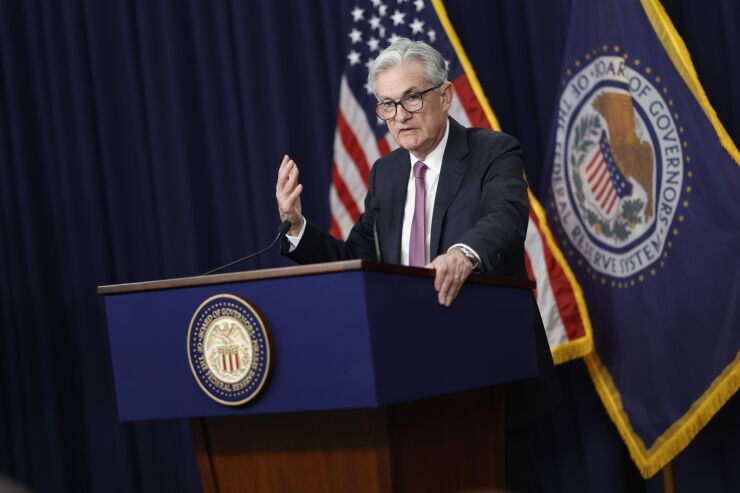
Bloomberg News
For banks, the macro backdrop is a mixed bag. But the U.S. economy’s durability and the banking industry’s
The KBW Bank Index was up 7% year to date through Tuesday and has jumped
“The American economy has just proven to be extremely resilient,” said Stacy Kymes, president and CEO of BOK Financial in Tulsa, Oklahoma. BOK’s shares are up more than 7% this year.
The $50 billion-asset BOK’s loan growth eased late in 2023 and early this year, and
“I’m very optimistic about growth broadly,” Kymes said.
At issue: The U.S. economy is slowing, and the job market shows signs of following suit amid a protracted era of high interest rates and festering inflation. The confluence of headwinds threatens to dampen business owner sentiment and keep a lid on
Yet the economy remains in modest growth mode and employment levels are solid. Conditions are cooling, but relative to past cycles, the economy “is performing well,” Kymes said.
Inflation, while elevated, is down more than 50% from its 2022 peak in the aftermath of the pandemic and Russia’s invasion of Ukraine. Global developments snarled supply chains and upended the international order for energy production, sending prices soaring. A flood of U.S. government stimulus compounded inflationary pressures. But Federal Reserve policymakers’ decision to jack up interest rates in 2022 and last year to cool inflation worked, economists and bankers say.
The $220 billion-asset Citizens Financial Group in Providence, Rhode Island, said its first-quarter business conditions index generated a reading of 48.2. A reading below 50 indicates that economic momentum slowed.
“The first-quarter index reading shows a business environment that is slowing as higher interest rates weigh on economic conditions,” said Eric Merlis, the company’s co-head of global markets. “While concerns about inflation persist, the data provides evidence that tighter monetary policy is having its intended effect.”
Inflation is hovering above 3% this year — well above the Fed’s preferred 2% level but far from this decade’s 9% peak in 2022.
As such, the Fed maintained its higher-for-longer posture with its benchmark interest rate after its latest policy meeting last week. It kept its target range at 5.25%to 5.5%, up from near zero at the start of this decade. The highest rate levels in 20 years have put upward pressure on deposit costs and crimped banks’ net interest margins in recent quarters.
“We’ve stated that we do not expect that it will be appropriate to reduce the target range for the federal funds rate until we have gained greater confidence that inflation is moving sustainably toward 2%,” Fed Chairman Jerome Powell told reporters after the meeting last week. “So far this year, the data have not given us that greater confidence.
“We are prepared to maintain the current target range for the federal funds rate for as long as appropriate,” Powell added.
Increased borrowing costs curbed loan demand and slowed overall activity — banks have reported flattish lending levels alongside a slowing pace of economic growth over the past two quarters.
Banks also have tightened lending standards to minimize inevitable increases in credit losses amid the higher rates. When credit costs rise, more borrowers struggle to make loan payments. Charge-off levels increased over the past several quarters, yet they remain low relative to historical norms.
But the Fed has not raised rates since July, and Powell indicated that not only are further hikes unlikely but policymakers’ next move on rates would probably be a reduction.
The latest jobs report, released last week, supported that thinking. The labor market held strong but showed another key sign of economic easing that could, by extension, help to lower inflation. U.S. employers added a seasonally adjusted
“While there was no change to interest rate policy, the Fed and Chairman Powell delivered much better-than-feared messaging to the markets on multiple fronts,” said Raymond James Chief Investment Officer Larry Adam. “They stated the dual-mandate goal of employment and inflation ‘have moved toward better balance over the past year,’ suggesting that some of the worry in recent months about the resurgence in inflation may be overblown.
“Additionally,” Adam added, “the Fed is focused on keeping interest rates stable for now and the bar for raising interest rates — a recent fear of the market — is very high. The next move, eventually, should still be a rate cut.”
All of which leaves banks in a holding pattern of sorts. The Fed’s latest senior loan officer survey in April showed they continued to tighten lending standards in the face of mostly flat demand in the first quarter. But the tightening developed at a slower pace than in the previous two quarters. “When banks start to moderate the level of tightening, within four to five quarters net charge-offs have historically peaked and bank stocks will rally ahead of peak” credit losses, analysts at D.A. Davidson said in a report.
This signals better days ahead, and futures market investors are getting ahead of the shift.
“We were glad to see that the results in both demand and standards were either similar to or not as bad as in the prior quarter’s results,” indicating that the industry has adjusted to high rates and is poised for a boost when the Fed does decide to cut borrowing costs, said Piper Sandler analyst Scott Siefers after the Fed survey.




